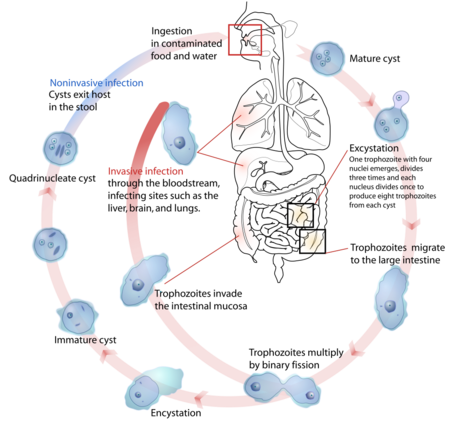Biology:Monoxenous development
From HandWiki
Revision as of 22:35, 24 May 2022 by imported>John Stpola (change)
Short description: One-host parasitic lifestyle

A monoxenous life cycle: the amoebozoan protist Entamoeba histolytica and its human definitive host.
Monoxenous development, or monoxeny, characterizes a parasite whose development is restricted to a single host species.[1]
The etymology of the terms monoxeny / monoxenous derives from the two ancient Greek words μόνος (mónos), meaning "unique", and ξένος (xénos), meaning "foreign".[2][3]
In a monoxenous life cycle, the parasitic species may be strictly host specific (using only a single host species, such as gregarines[4]) or not (e.g. Eimeria, Coccidia).
References
- ↑ Odening, Klaus (1976-01-20). "Conception and terminology of hosts in parasitology". in Dawes, Ben (in en). Advances in Parasitology. 14. Academic Press. pp. 23. ISBN 978-0-08-058060-9. https://books.google.com/books?id=rcRtCavuUYEC&pg=PA23.
- ↑ Bailly, Anatole (1981-01-01). Abrégé du dictionnaire grec français. Paris: Hachette. ISBN 978-2010035289. OCLC 461974285.
- ↑ Bailly, Anatole. "Greek-french dictionary online". http://www.tabularium.be/bailly/.
- ↑ Leander, B. S. (1 January 2003). "Phylogeny of gregarines (Apicomplexa) as inferred from small-subunit rDNA and beta-tubulin". International Journal of Systematic and Evolutionary Microbiology 53 (1): 345–354. doi:10.1099/ijs.0.02284-0. PMID 12656194.
External links
 |

